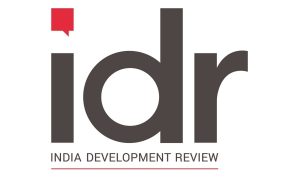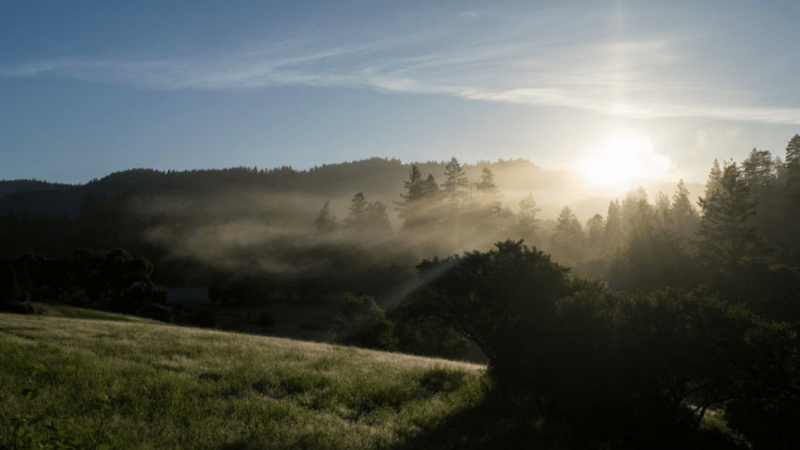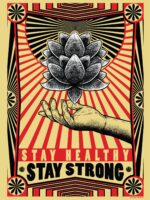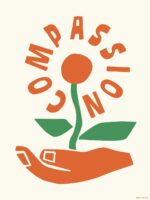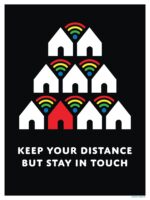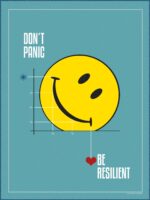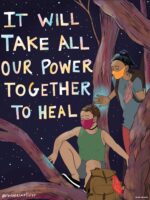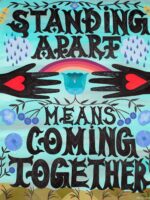
Institute for Collective Wellbeing
Location: Madison, Wisconsin,
United States of America
Can you share the intention behind creating the Institute for Collective Wellbeing (ICW) and what communities the Institute serve?
The intention behind ICW is to reimagine the purpose of organizations, systems, and society in service of collective wellbeing. It can be hard to transform a system from the inside due to bureaucracy, a sense of inevitability or stuck mindsets, and strongly embedded power differentials. We dreamt of something bigger – something more expansive and more aligned with a sense of possibility. So we took a leap of faith to co-create ICW free from stories about what we need to do, or who we need to be, in order to find purpose and meaning in organizational life.
We’re on a journey to be a microcosm of the world we aspire to see. It is very hard work! Increasingly, we understand that a society that honors collective wellbeing is also one that has reverence for the unknown. Our research and programming engage stakeholders across nonprofit, government, private, academic, and community sectors, and we are pleased with how often participants identify common ground in our often deeply siloed world.
The common thread among communities we serve is a shared commitment to authentic, inclusive, and generative relationships that are at the heart of systems transformation.
The mental models of what it means to be a “successful” organization don’t always align neatly with our commitment to an emergent strategy and a deeply relational ethos, but we’re doing it anyway.
What are some of the Institute’s focus themes?
There are so many! Here’s one that has been showing up a lot recently: As part of a study we’re conducting with our colleagues at <a href=”https://santamonicawellbeing.org/” target=”_blank” rel=”noopener”>Civic Wellbeing Partners</a>, we’ve interviewed leaders across silos and sectors globally to learn how stakeholders create conditions for collective wellbeing to emerge within their organizations and the communities they serve.
We hypothesize that one of the drivers at play is a lack of attention to mental models. Mental models are at the root of our systems and include our beliefs, values, and even consciousness. Time and again, we hear about programs, policies, and structures they have built to address racial inequity, the climate crisis, individual and collective trauma, etc. Yet there is repeatedly a narrative of burnout and/or a sense of bumping up against the limits of what a system will allow when it comes to real transformation.
For example, we can say we value collective wellbeing at our organization, but if employees feel like they need to “turn off” parts of who they are at work, is that collective wellbeing? What if one “big boss” ultimately speaks for the collective? What if we can’t share a viewpoint without data to back it?
These kinds of questions are critical when we work in service of collective wellbeing because even the best of intentions can prove futile if grown in poor soil, so to speak. It’s at the roots where mental models change the quality of the conditions by which transformation takes hold.
The Institute talks about the goal of co-creating Wellbeing for all.
What does that look like?
First, co-creation speaks to our desire for a deeply relational and collective approach. We push back on the idea that we need to assert our expertise, or lead from a place of power or hierarchy, in order to realize change. On the contrary, we feel a sense of harmony within ourselves, each other, and the universe when we honor the wisdom of one another.
When we attempt short-sided efforts to address wellbeing, we quickly see the error of our ways. For example, when organizations support remote work but insist on tracking people’s time use, they lack trust. When they promote racial/social/gender equity for the communities they serve but do not do the same for their internal teams, they lack insight. When they espouse a commitment to the environment but frequently fly staff across the globe without regard to planetary impacts, they lack consistency.
Collective wellbeing for all speaks to the idea of interconnection. We honor the fact that our wellbeing is wrapped up in the wellbeing of others and the earth.
Collective wellbeing for all is not a panacea nor does it address all social ills, rather, it moves us in the direction of awareness of how our actions impact ourselves, others, and the planet, and it is a vision of what’s possible.
[mk_padding_divider size=”10″]
What are three things people interested in collective wellbeing can do to learn or put it into practice in their organization?
1. Engage change at various levels simultaneously
The interconnectedness of transformation at the personal, organizational, community, and planetary dimensions provides a holistic approach to collective wellbeing. Each dimension supports and relies on the others. Collective wellbeing is difficult when we prioritize one over another. That’s not to say that organizations need to do it all. Rather, make decisions with all dimensions in mind.
2. Pay attention to mental models
As discussed, surfacing “hidden” mental models helps us see the roots of suffering. For example, when working on equity issues, we may not see “hierarchy” as a mental model that contributes to inequity. We may have diversity among leadership but still support a system where a small group of individuals has power over others. An alternative is an “ecosystem” approach where power rests in relationship to one another and the system as a whole. Other shifts include: short to long-term thinking, fixed/static to emergent, tasks to relationships of care, rational to embodied, etc. What mental models are operating in your life that might benefit from a shift?
3. Practice collective wellbeing daily
Start every meeting with a wellbeing check-in to help each other feel seen and to decompress before starting the work. Sometimes our check-ins become the meeting because we believe so strongly that all parts of our lives are interconnected. Other practices include: self-managing structure; engaging one’s purpose and purpose of the organization; opening to emergent opportunities (not wedded to fixed outcomes); and adapting to a slower pace – questioning urgency.
What does the Institute imagine the future of wellbeing to look like?
Adrienne Maree Brown said, “We’re in a time of new suns. We have no idea what we could be, but everything that we have been is falling apart. So it’s time to change. And we can be mindful about that. That’s exciting.” For all that feels broken, uncertain, painful, and cold in the world, there is an opening underway, and it is powerful. It often doesn’t make headlines, and it’s far more intuitive than practical, but it is happening!
The future of collective wellbeing lives in the space between the systems that are dying and those that are waiting to be born. It is supple, feminine, honest, and imaginative. And if honored, it will reveal to us what our rational minds cannot; a change that will favor the collective wisdom and wellbeing of all people and the earth. As Arundhati Roy said, “Another world is not only possible, she is on her way. On a quiet day, I can hear her breathing.”
This may seem vague, and that’s okay! Part of embracing collective wellbeing is valuing what we feel even if we can’t say why at this moment. For readers interested in learning more about how we see the future of collective wellbeing unfolding, we welcome you to register for our 1-day virtual summit on September 15, 2022.
If ICW were an animal, what would it be and why?
So many animals are brilliant in their embodiment of transformation – the snake, the butterfly, the raven, etc. It’s hard to pick just one! There is the Lion featured prominently in the story of the Hindu Goddess Durga, a symbol of destruction for good, which seems apt.
Perhaps we’ll go with one that comes up in a phrase we like, “the elephant in the room;” alluding to something uncomfortable and often avoided.
To be clear, we don’t think of ICW as an organization that is uncomfortable or that should be avoided. Rather, what we mean is that we don’t shy away from complexity. We gravitate towards the deeply embedded narratives and mental models of what collective wellbeing means and what it takes to bring it to life. We move toward what is unknown, guided by a sense of what is possible rather than a certainty of what’s to come. Because that’s the thing about the elephant in the room. Whether or not you can put your finger on what it is, you know it’s there. How you respond often depends on what you believe is possible and if you dare to act on what you sense is true.
If you would like to learn more about Institute for Collective Wellbeing or are interested in supporting ICW’s work, please message the team at info@tifcw.org.


